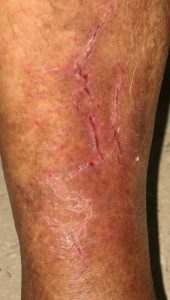Chapter 3: Eczematous Disorders
Asteatotic Dermatitis
What is it?
It is a type of eczema that appears as a cracked dry riverbed from excessive dryness. Exposure to hot water, using harsh soaps or malnutrition can result in astetotic eczema. It is thought to be secondary to loss of epidermal lipids and natural moisturizers.

What does it look like?
Dry skin that progress to form superficial cracks or fissures on a background of faint erythema. Often seen on the lower extremities, where scales are thick or on the upper back in patients exposed to hot showers.
How is it treated?
Topical steroids, preferably in an ointment base, rapidly clears the skin. Calcineurin inhibitors can also be used. Aggravating factors like hot showers, harsh soaps and bath scrubs should be avoided. For prevention, multiple daily applications of a thick moisturizer, preferably petrolatum jelly or moisturizers that contain ceramides and humectants.

